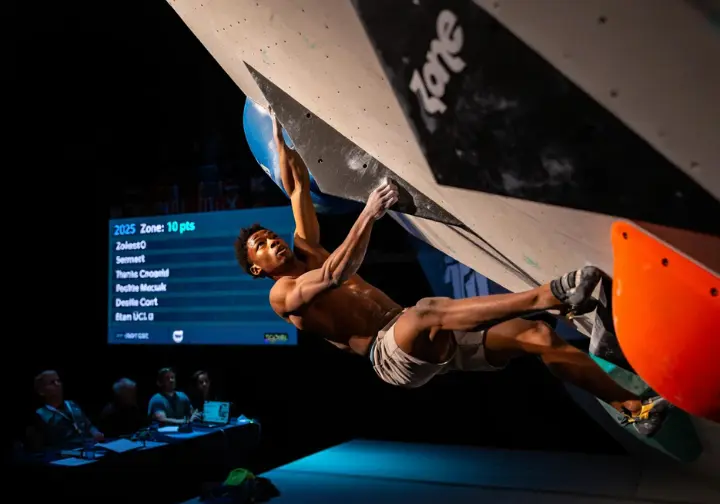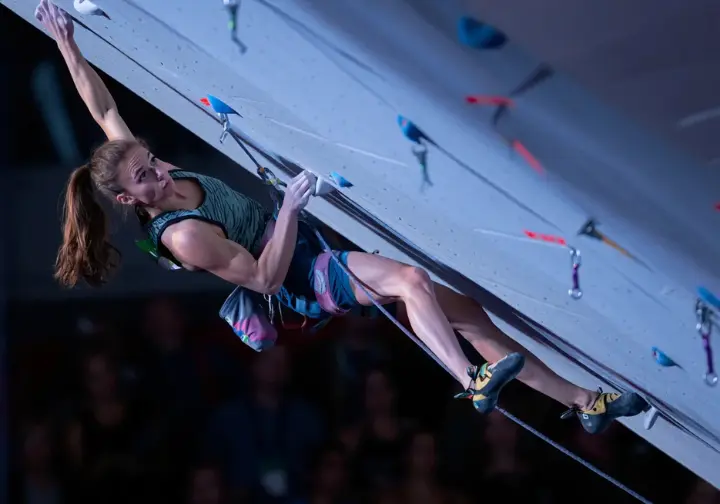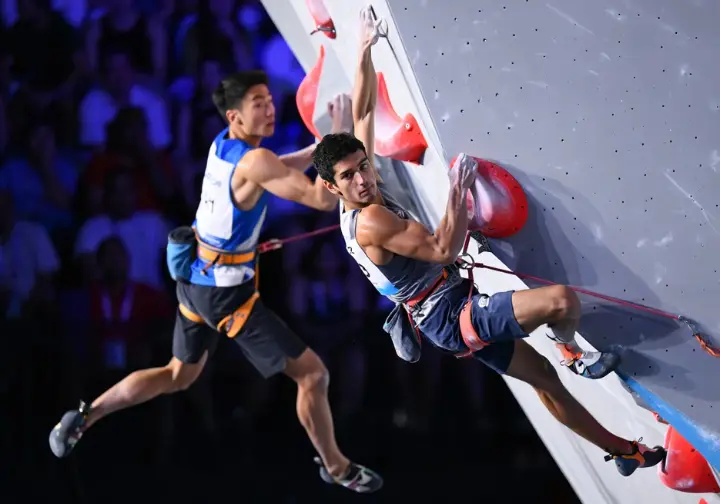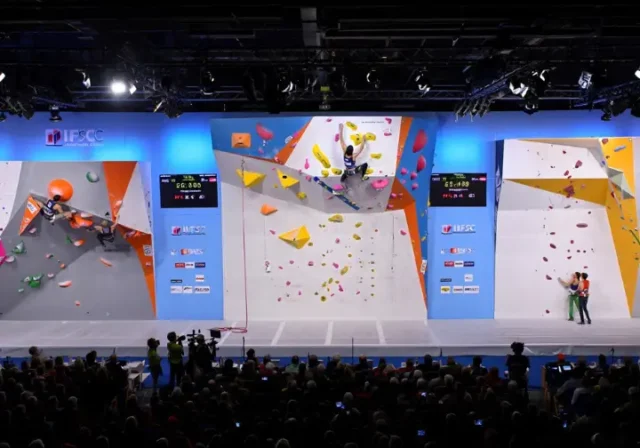In this article
The world of competitive climbing is more dynamic and fast-paced than ever. For avid fans and aspiring competitors, this guide to IFSC formats: scoring, rules & rounds serves as a definitive resource for understanding the three core disciplines of the IFSC World Cup circuit: Boulder, Lead, and Speed. We’ll provide a comprehensive breakdown of the different climbing competition formats, each competition round, and key regulations. We will place a special focus on the pivotal 2025 rule changes that are reshaping the competitive landscape of this international sport. Grasping these formats is essential to enhancing the spectator experience and appreciating the strategic depth of the sport.
The Foundation: Understanding the IFSC World Cup Circuit

To fully appreciate the competition, it’s helpful to first understand the structure behind it. Let’s explore the role of the IFSC as the main organizing body, the flow of the annual competition series, and provide a top-level overview of the three core disciplines before we dive into the specific rules for each.
The Role of the IFSC and National Federations
The International Federation of Sport Climbing (IFSC), established in 2007, is the paramount global governing body for competitive climbing. Its primary mission is to standardize competition rules, promote the sport globally, and organize prestigious events like the World Cup Series and World Championships. The federation‘s work, guided by its statutes and IFSC regulations, ensures fairness for every athlete and was instrumental in explaining how Olympic climbing works to get the sport included in the Olympic Games.
National Federations are the member bodies representing climbers at the country level. They are responsible for registering their national teams for IFSC events and ensuring their athletes maintain compliance with all regulations. These organizations act as the critical link between the athletes and the international governing body. The IFSC also collaborates closely with the International Olympic Committee (IOC) to determine formats for the Games, which has led to separate medal events for each discipline in Los Angeles 2028, mirroring the World Cup.
The Three Core Disciplines: A Snapshot
Boulder is a discipline that zeroes in on explosive strength, technique, and problem-solving. Climbers attempt to complete a short sequence of moves on powerful routes called ‘problems’ on low walls around 4-4.5 meters high without ropes. The inherent risk is managed by thick safety matting below. The true challenge lies in executing a small number of incredibly difficult moves to solve the short, powerful routes called ‘problems’.
Lead climbing is the ultimate test of endurance and route-reading ability. Athletes climb as high as they can on a wall that is 15 meters or taller within a strict six-minute time limit. They must clip their rope into a series of pre-placed quickdraws for safety as they ascend. The goal is to reach the designated “Top” hold or simply achieve a higher score than any other competitor on the long, sustained course.
Speed is a pure, head-to-head race to the top against both an opponent and the clock. Competitors in speed competitions scale a standardized 15-meter wall where the hold layout is an identical international standard across all competitions worldwide. This format is all about explosive power, precision, and raw speed, with results often decided by mere hundredths of a second.
The Boulder Discipline Explained: Power, Puzzles, and Points (2025 Update)

Now, we dive into the first discipline: Boulder. We will cover the competition’s objective, the progression through its structured rounds, and pay close attention to the significant new scoring system and format changes being implemented for the 2025 competition series.
Boulder Objective and Round Progression
The primary objective in bouldering is to “solve” a series of short, complex routes by reaching and controlling the final “Top” hold. These problems, set by an IFSC routesetter, demand a blend of power, technique, and creative problem-solving. Athletes typically have a four or five-minute time limit to make as many attempts as needed to complete each problem. Before the semi-final and final rounds, athletes get a collective round preparation period to inspect the problems without climbing.
A competition unfolds across three competition rounds. The Qualification round features a large field of athletes on about five problems. For the 2025 season, the Semi-Finals will see the top 24 athletes advance from qualification to attempt four new problems. The Finals round now features the top 8 athletes from the semi-finals. A key 2025 change is a new rotation protocol where multiple climbers can be on the mats at once, ensuring continuous action for spectators watching the official IFSC broadcast.
Understanding the New 2025 Boulder Scoring System
The IFSC introduced a new, points-based scoring system for 2025 to make the IFSC competition scoring easier for fans to follow. The old system has been replaced. Now, successfully controlling the final Top hold of a problem earns a climber a flat 25 points. Each boulder problem also features a single designated intermediate scoring hold called a Zone. Successfully controlling this Zone hold earns the climber 10 points, but this score is only awarded if the climber does not subsequently achieve the Top.
A small penalty is applied for each fall; 0.1 points, a decimal value, are deducted from the final score achieved on that specific problem. For instance, reaching a Top in three attempts results in a scoring result of 24.8 points. An athlete’s total round score is the sum of points from all problems. This new system changes athlete strategy, as the advantage of a Zone may encourage securing those points first. If athletes have the same score, their final ranking is decided by countback to the previous round’s results.
The Lead Discipline Explained: Endurance, Height, and Precision

Moving from explosive power to sustained effort, we arrive at the Lead discipline. Here we’ll explore the core objective of lead competitions, the progression through competition rounds, and the specific nuances of a scoring system where every hold—and second—counts.
Lead Objective and Round Progression
The fundamental goal in Lead is to ascend as high as possible on a long, difficult route within a 6-minute time limit. Competitors climb on walls that are typically 15 meters or more, secured by a rope which they must clip into a series of pre-placed quickdraws as they go. The competition follows a standard progression. The Qualification round consisting of two routes determines the initial qualification ranking.
For 2025, the top 24 athletes advance to the Semi-Finals, a change from 26 in previous years. Here, they attempt one new route under “on-sight” conditions. This strict protocol means they have a 6-minute observation period beforehand but are kept in an isolation zone to prevent them from watching others climb. The top 8 athletes from this semi-final round proceed to the Finals, where they face one last, exceptionally difficult route under the same “on-sight” rules.
Lead Scoring and Tie-Breaking Rules
Scoring in Lead is based on the highest numbered hold an athlete successfully uses or controls. Each hold on the course is assigned a sequential number, and the hold number itself is the primary score. Reaching the final anchor at the top is scored as a “Top”. To differentiate between climbers who fall between holds, a “+” notation is added if an athlete makes a controlled movement towards the next hold, which ranks higher than a score without it.
Ties are common, so clear technical rules are essential. If multiple athletes achieve the same score, the tie is first broken by time; the athlete who reached that high point faster is ranked higher. In the rare case that scores and times are identical, a final tie-breaker known as countback is used. The athlete who had a better rank in the preceding round will be awarded the higher position in the final ranking.
The Speed Discipline Explained: A Vertical Sprint

In stark contrast to the strategic puzzles of Boulder and the endurance test of Lead, Speed climbing is an all-out vertical sprint. Get ready to explore the specific format that makes world records possible, the lightning-fast qualification process, and the thrilling tournament-style round in the finals.
The Standardized Speed Format
Speed climbing is a vertical race where athletes compete side-by-side on a standardized 15-meter high wall set at a 5-degree overhang. This standardization is crucial, as the holds and their exact placement are identical in every IFSC competition, which allows for official world records. An automatic timing system starts when an athlete leaves the starting pad and stops when they hit a switch. For safety, all athletes are secured by an auto-belay system meeting the EN-15151-2 standard.
A critical part of the speed climbing rules is the false start. A false start, which leads to disqualification for that run, is registered if an athlete’s reaction time is less than 0.100 seconds after the final starting beep. Having an IFSC Speed Licence is a prerequisite for entry into such competitions.
Speed Qualification and Finals Bracket
The competition begins with a Qualification round. In this round, each athlete gets two runs. Their single fastest valid time from these two runs is used to create a seeded ranking to determine who will advance to the next round. If an athlete has a false start on one run, it is recorded as ‘FS’ and ranks below any valid time, but they can still use their other time for seeding.
The top 16 fastest athletes from qualification advance to the Finals round. This is a head-to-head elimination bracket where athletes are paired based on seeding (1st vs 16th, etc.). In these elimination heats, a single false start results in an immediate loss. The bracket progresses through a Round of 16, Quarter-Finals, and Semi-Finals. The two winners of the semi-finals race in the Big Final for 1st place, while the two losers compete in the Small Final for 3rd and 4th place.
The Bigger Picture: Season Rankings and Championship Events

With a solid grasp of the individual disciplines, let’s zoom out to the larger competitive ecosystem. Here, we’ll see how athletes win the overall season title, earn their IFSC World Rankings, and clarify the important distinctions between World Cups, World Championships, and the Olympic Games.
How Overall World Cup Champions Are Crowned
The IFSC World Cup is an annual competition series, and the ultimate goal for many is to win the overall season title and competition trophy. Athletes earn ranking points at each cup competition based on their finishing position. A victory is worth 1000 points, 2nd is 805, and so on. These points from the cumulative points system are tallied, and the athlete with the highest final score is crowned the overall World Cup Champion. This system rewards consistent high-level performance. In seasons with many events, the rules often allow athletes to drop their worst results.
World Championships vs. The Olympic Games
The IFSC World Championships are prestigious, standalone international competitions typically held every two years. Winning the World Championship is a one-off achievement that crowns a single-event World Champion. Eligibility is managed through national federation quotas, which are heavily influenced by a nation’s performance in the World Cup circuit. The IFSC also governs IFSC Paraclimbing, with its own classification rules and para sport classes.
The Olympic Games format has evolved significantly. After different combined formats, the Los Angeles 2028 Games will feature separate medal events for Boulder, Lead, and Speed, bringing the specific rules much closer to the World Cup structure. Both the World Cup and World Championships are critical components of the Olympic qualification pathway, where strong results are essential for athletes to earn quota spots for their country.
Conclusion: Appreciating the Evolving World of Competitive Climbing
Understanding the distinct rules, scoring, and pressures in Boulder, Lead, and Speed is the key to fully appreciating the depth of elite climbing. Each discipline tests a unique combination of physical power, mental endurance, and strategic thinking. The sport is not static; the 2025 rule changes, especially the new points-based Boulder scoring, demonstrate the IFSC Executive Board‘s commitment to making the sport more engaging and understandable for a growing global audience.
The next time you watch an IFSC World Cup, pay close attention to the strategic nuances. In Boulder, track the points, not just the Tops. In Lead competition, watch the clock during potential tie-breakers. In Speed, look for the flawless execution that separates winners. By demystifying these formats, we hope to transform your viewing from simple observation into an informed and exciting analysis, deepening your connection to the incredible athletes of competitive climbing.
Frequently Asked Questions about IFSC Climbing World Cup Formats
Why did the IFSC change the Boulder scoring system for 2025? >
What does “countback” mean in a tie-breaker? >
Is the Speed climbing wall really the same everywhere? >
What does “on-sight” mean in Lead climbing? >
We are a participant in the Amazon Services LLC Associates Program, an affiliate advertising program designed to provide a means for sites to earn advertising fees by advertising and linking to Amazon.com. As an Amazon Associate I earn from qualifying purchases. We also participate in other affiliate programs. The information provided on this website is provided for entertainment purposes only. We make no representations or warranties of any kind, expressed or implied, about the completeness, accuracy, adequacy, legality, usefulness, reliability, suitability, or availability of the information, or about anything else. Any reliance you place on the information is therefore strictly at your own risk. Additional terms are found in the terms of service.









